Water flows from below under the Atlant washing machine
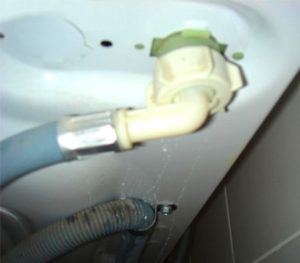 An unexpected and unpleasant surprise will be a puddle under the Atlant machine. You cannot simply wipe off the water and continue using the washing machine; this is very dangerous. Firstly, there is a high risk of flooding not only your apartment, but also your neighbor’s. Secondly, a short circuit may occur and lead to dire consequences. Let's figure out why water is flowing from below the machine, what actions can be taken in such a situation without calling a technician.
An unexpected and unpleasant surprise will be a puddle under the Atlant machine. You cannot simply wipe off the water and continue using the washing machine; this is very dangerous. Firstly, there is a high risk of flooding not only your apartment, but also your neighbor’s. Secondly, a short circuit may occur and lead to dire consequences. Let's figure out why water is flowing from below the machine, what actions can be taken in such a situation without calling a technician.
Why did the leak form?
Not a single washing machine is completely insured against leaks, and the Atlant model is no exception. Leakage can be caused by manufacturing defects, incorrect connection of equipment to communications, or careless operation of equipment. First, you need to understand why the accident occurred.
The main reasons leading to the Atlant washing machine leaking:
- violation of the rules for using equipment;
- use of low-quality detergents unsuitable for automatic machines;
- mechanical defect, natural wear and tear of washing machine parts;
- installation of components of poor quality;
- incorrect connection of the device to house communications;
- defect caused by the manufacturer.
If the cause of the leak is low-quality spare parts or a manufacturing defect, the washing machine will begin to leak almost immediately after purchase or the next repair.
Speaking of wear, the following elements are most susceptible to wear on Atlant machines: drum, drain pump, drain system pipes, sealing collar, inlet and drain hose, tank seal, powder receptacle.This is where all sorts of breakdowns most often occur, for example, violation of the integrity of parts or their tightness. This causes the washer to start leaking during washing.
You can find the cause of the leak and try to fix it yourself. You will have to check each of the described elements of the Atlant washing machine. But before you start diagnosing, you need to quickly drain the water from the machine and eliminate the large puddle that has spread across the floor.
Urgent actions
If you see a wet spot near an automatic machine, you need to be careful. Water in combination with an electrical appliance connected to the network is always dangerous to life and health. It is strictly forbidden to touch or step into a puddle until the equipment is disconnected from the power supply. Even if the machine has not yet finished the washing program, you need to quickly unplug the power cord from the outlet.
If the outlet is located very close to the washing machine, it is advisable to cut off the electricity supply completely in the room or apartment through the switchboard.
The subsequent algorithm of actions will be as follows:
- close the shut-off valve (responsible for supplying water to the machine);
- wipe away any wet stain around the body;
- drain the water from the system through a garbage filter;
- move the washing machine away from the wall or take it out of the niche (if the appliance is built-in);
- inspect the unit.
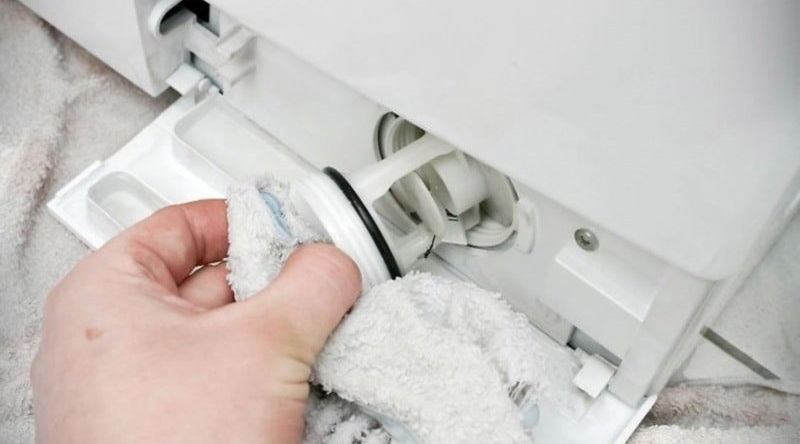
To understand why the Atlant washing machine is leaking, you will have to remove the back, top or side (on top-loading machines) wall of the case. Some models will need to be tilted towards you and a platform placed under the bottom of the machine to look inside. It is very important to understand at what stage of the cycle the washer began to leak, then it will be easier to localize the breakdown.
You should also look at the water - if it is dirty, it means it started flowing out in the middle of the wash, if it is clean, it means at the very beginning or at the final stage. Let's analyze in order all the elements of the machine that can become the “culprits” of the leak.
Water intake hose
Very often the culprit of a small flood is the inlet hose. Perhaps it is poorly fixed at the joints, worn out, bent, worn out, pinched by a foreign object. To determine the cause, carefully inspect the tube.
You can check the water intake hose without plugging the washing machine into the outlet. The algorithm of actions will be as follows:
- remove the “top” of the washing machine;
- disconnect the rear panel of the unit;
- tilt the washer forward, place something like a platform under the bottom;
- inspect the inlet hose for defects, cracks, and crevices at the joints;
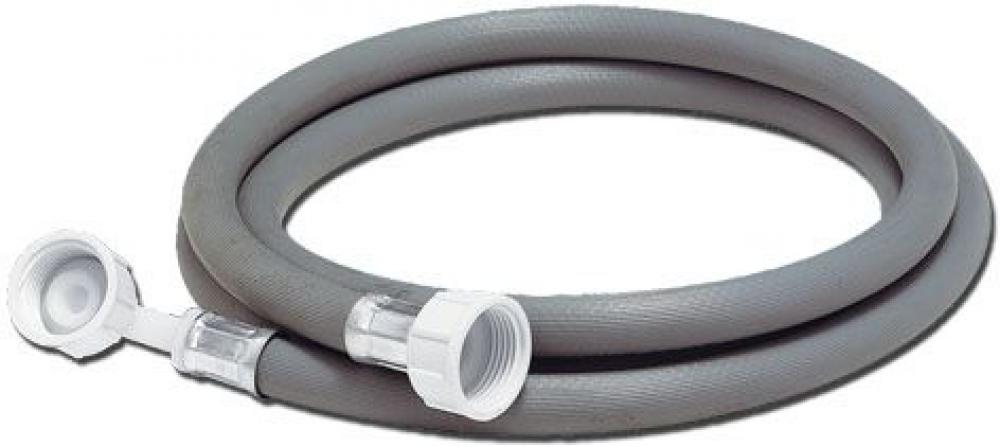
- if there is no visual damage, wipe the entire surface of the tube with a dry cloth;
- turn on the water supply, watch carefully to see if splashes or drops appear on the hose.
Dryness will show that there is no point in changing the rubber pipe. If there are defects, the leakage area will “give” itself away. Having found a crack, do not try to seal it with tape or tape, or treat it with sealant. The inlet hose is under pressure, so if damaged, it will have to be completely replaced. If the leak comes from the joints, you can deal with the problem by replacing the gaskets and tightening the joint area well.
Look at the water that has flowed out
Dirty water under the washing machine Atlant will tell you that the water intake hose is not to blame for the leak. A spent, cloudy liquid indicates a leak from the lower elements of the washer: tank, drain pipe, drainage hose, pump, garbage filter.
Turn on the “Rinse” mode on your automatic machine and watch the equipment work. If it leaks from the drain hose, you will have to replace the corrugation. Buying a hose is very simple - components for machines of the Belarusian brand are sold freely in plumbing departments or on the Internet.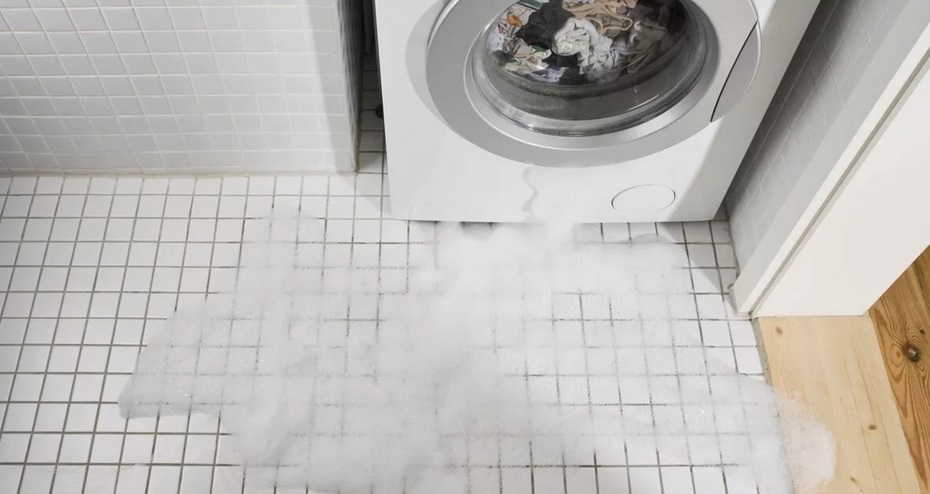
It is possible that water will flow out from the joints of the hose with the siphon, pump, or snail. It's probably because the fixation has weakened. The sealing gaskets should be replaced, the fastening should be strengthened with a clamp, and moisture-resistant silicone sealant should be used.
Intake valve pipes
Clear water may indicate problems with the pipes connecting the fill valve and the powder receptacle. It’s very easy to check your guess - just open the dispenser and see how well the detergents are washed out of the sections. If the powder is wet but not completely dissolved, it means the pipe is leaking.
To troubleshoot the problem:
- detach the top panel of the machine;
- find the pipes leading to the detergent dispenser and inspect their surface;
- change hoses if defects are detected;
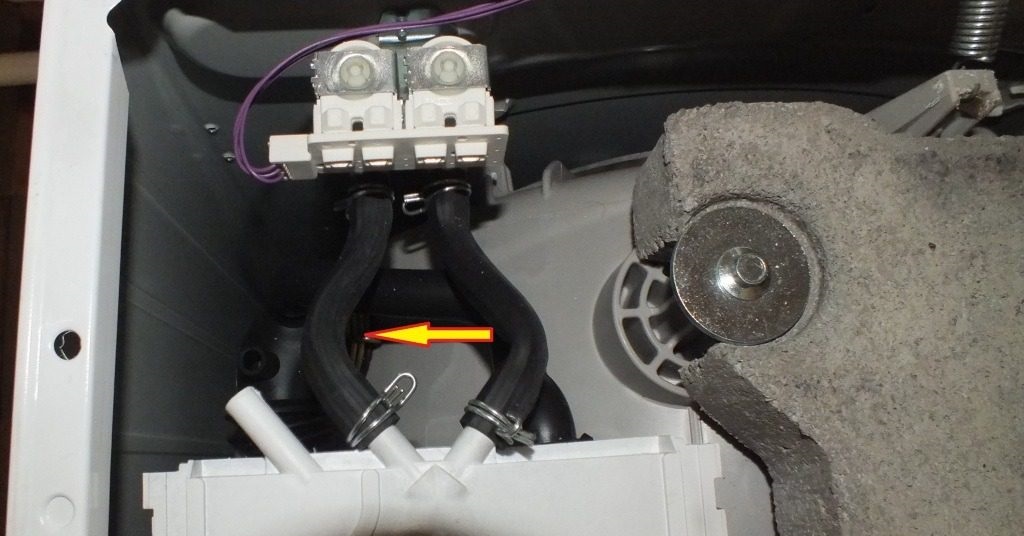
- tighten the clamps more tightly;
- assemble the washing machine.
With such a breakdown, the leak will not be strong. The user can find out about the problem immediately after starting the wash. Water will flow into the powder receptacle in insufficient volume, and some of it will spill out.
The pipe between the tank and the snail
In rare cases, the cause of a leak may be the drain pipe located under the tank of the Atlant machine. There is always water in this hose, so the “lake” under the machine will not stop increasing even after the unit is turned off. Having noticed that the leak does not stop, you can safely write down this pipe as the “culprit”.
You can deal with the problem yourself. The algorithm of actions is quite simple. You should remove water from the drain system by unscrewing the garbage filter, then put the machine on its side, disconnect the pipe and secure the new element in place. Replacement parts are sold in special stores.
It is important to tighten the clamps well to minimize the risk of emergency leaks in the future.
Drain pump
If water is flowing from below, the problem may be in the pump. It is also located at the bottom of the washing machine. To get to it, you need to drain the water through the filter and lay the machine on its side. Check the pump, disassemble it if necessary and clean it thoroughly from the inside.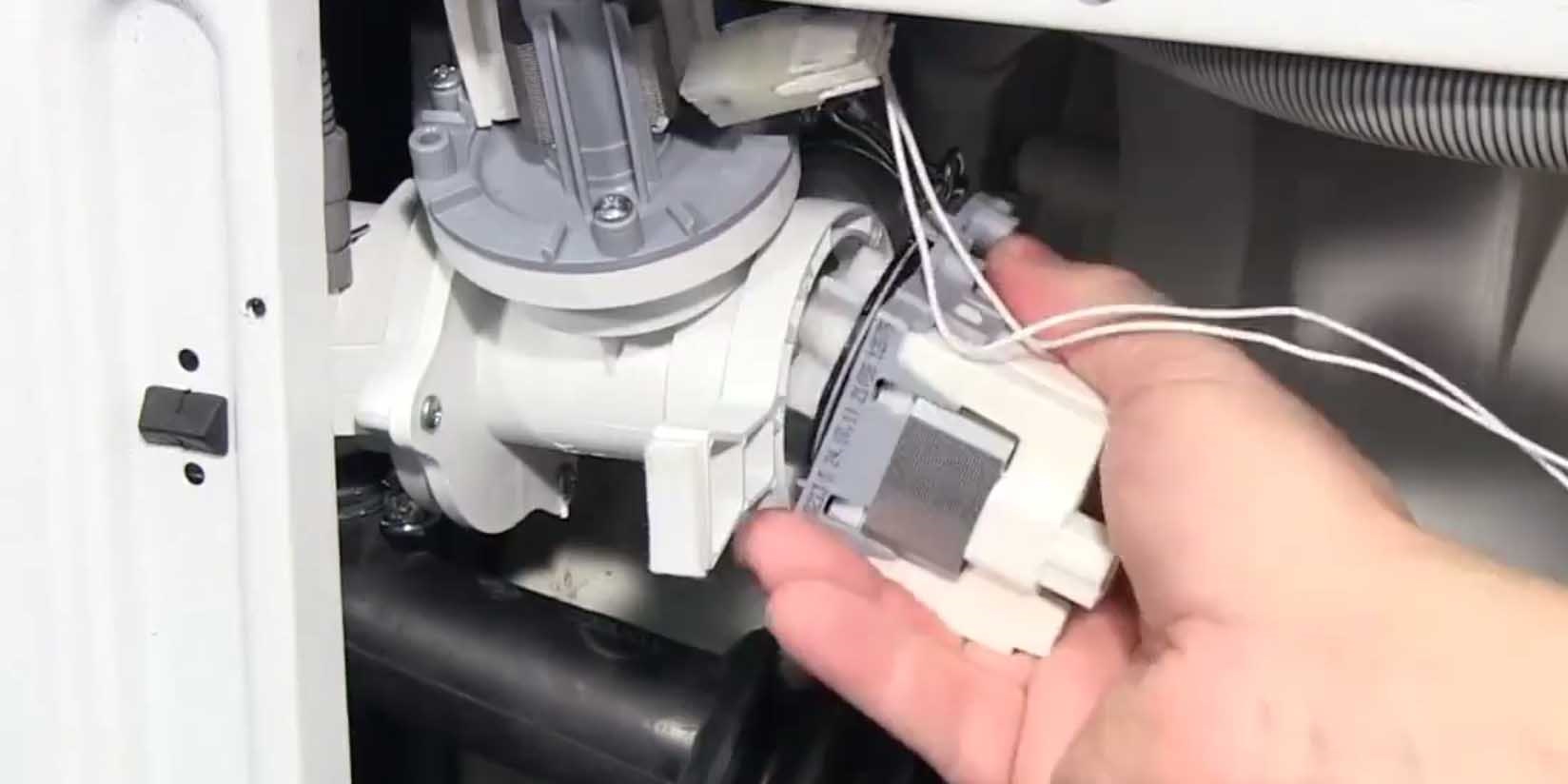
When the pump looks like it is working properly, take a closer look at the snail; it should be dry, without any cracks or defects. If damage occurs, there was probably a manufacturing defect, as a result of which the coil broke and began to leak moisture. Only replacing the element will help.
The main tank is broken
If the “lake” under the machine is of impressive size and the water is soapy, we can assume that the problem is in the drum. The main tank of the washing machine often suffers from overload with things, foreign objects (coins, bra underwire, buttons, etc.) As a result of this impact, cracks appear on the walls of the tank and water begins to leak out.
To check your guess, you will have to inspect the internal elements of the washing machine for “sputum”. This is where a flashlight comes in handy. The frontal automatic machine must be placed at an angle; for the horizontal machine, remove the side wall and try to find places where water accumulates.
You can carry out local repairs by sealing the hole in the tank with a special moisture-resistant compound that will restore the seal.The crack will close, but only for a while. To put an end to the problem once and for all, you will have to install a new unit. It will be difficult for the average person to replace the element on their own, so it is better to seek help from specialists.
If the drum consists of two halves, a simple replacement of the gasket will probably solve the problem. The work is quite labor-intensive, it is advisable to entrust it to a master.
Hatch cuff and powder box
These elements are also included in the list of causes of possible leaks. Most often, we are not talking about their wear and tear, but about the negligence of the users of Atlant washing machines. For example, the powder receptacle is usually clogged with a low-quality detergent or a foreign object that accidentally ends up in the cuvette. If the tray is dirty, you need to thoroughly clean the dispenser to remove any clogs.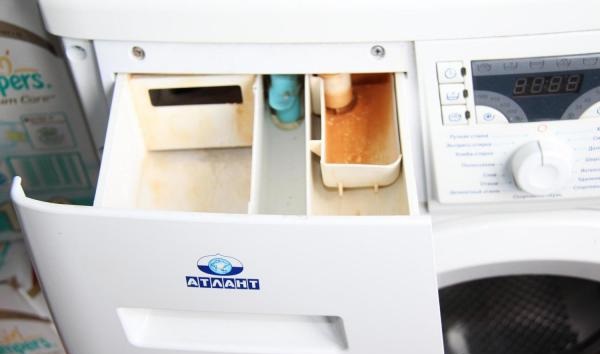
The hatch door seal is easily damaged by sharp objects caught in the machine drum. Also, the elastic can be damaged if you load things carelessly and remove the laundry after washing. A cuff defect disrupts the tightness of the system, which means it increases the likelihood of leaks. In this case, water leaks from under the hatch, and it seems that it is pouring from below.
There is no need to try to seal the rubber seal; it is more advisable to install a new cuff.
Safety precautions
To avoid leaks during washing, you should follow the basic rules for using the washing machine and ensure proper care of the equipment. If you follow the manufacturer’s recommendations, many problems associated with water “breaks” can be easily avoided. What advice are we talking about?
- When washing wardrobe items with metal inserts, stripes and other small details, use special bags.
- Do not leave the machine to work uncontrollably for 2-3 hours, “visit” the machine from time to time, check that everything is going according to plan. The sooner a leak is detected, the easier it is to deal with its consequences.
- Always unplug the power cord from the outlet after using the machine.
- Do not place washing equipment in rooms with high humidity.
- After finishing the wash, run an “empty” cycle to rinse the inside of your equipment.
- Strictly observe the maximum weight of dry laundry allowed for loading into the drum.
- Install an additional filter in front of the automatic machine if the water in the pipes is too hard.
- Use only high-quality detergents designed for automatic machines.
- Do not forget about cleaning the elements of the drainage system - periodically rinse the garbage filter and drainage hose. This will avoid blockages.
Having an idea of what to do if you find a puddle under the machine, you can prevent flooding of the neighbors below, avoid electric shock, and prevent damage to the washing machine. In addition, you don’t have to call a specialist and pay for repairs - most of the problems that cause leaks can be easily solved on your own. The main thing is to act clearly and carefully, following the recommendations described above.
Interesting:
Reader comments
- Share your opinion - leave a comment



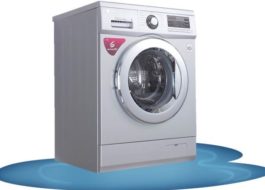
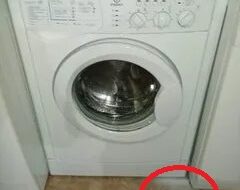
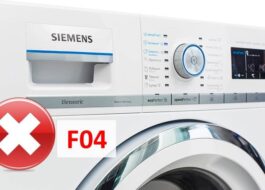
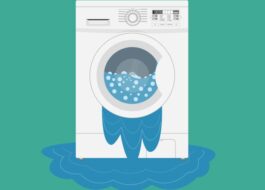














Add a comment